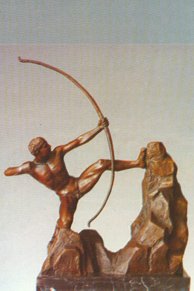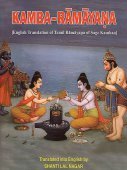Nagapasha, Naga-pasha, Nāgapāśa, Nāgapāsa: 16 definitions
Introduction:
Nagapasha means something in Buddhism, Pali, Hinduism, Sanskrit, Marathi. If you want to know the exact meaning, history, etymology or English translation of this term then check out the descriptions on this page. Add your comment or reference to a book if you want to contribute to this summary article.
The Sanskrit term Nāgapāśa can be transliterated into English as Nagapasa or Nagapasha, using the IAST transliteration scheme (?).
Images (photo gallery)
In Hinduism
Shaktism (Shakta philosophy)
Source: Wisdom Library: ŚāktismNāgapāśa (नागपाश, “the noose of serpents”) is a Sanskrit word for a weapon used in Purāṇic literature, such as the Devī-bhāgavata-purāṇa (9.20.22-53), where it was in the presence of Devī Bhadrakālī, who was preparing for the war between Śankhacūḍa with the Devas.
Source: Google Books: ManthanabhairavatantramNāgapāśa (नागपाश) refers to a “snake and noose”, according to the Kulakaulinīmata verse 3.82-88.—Accordingly, “[...] 4) Chedinī (the Piercing One) is blue. She holds a sword and club (kheṭaka). 5) Dakṣā (Skillful) is dark blue and, auspicious, holds a snake and noose [i.e., nāgapāśa-dharā]. 6) Strī is yellow and has a flag as (her) attribute. [...]”.

Shakta (शाक्त, śākta) or Shaktism (śāktism) represents a tradition of Hinduism where the Goddess (Devi) is revered and worshipped. Shakta literature includes a range of scriptures, including various Agamas and Tantras, although its roots may be traced back to the Vedas.
Purana and Itihasa (epic history)
Source: Cologne Digital Sanskrit Dictionaries: The Purana IndexNāgapāśa (नागपाश).—Varuṇa's wedding present to Kāmeśvara.*
- * Brahmāṇḍa-purāṇa IV. 15. 20.

The Purana (पुराण, purāṇas) refers to Sanskrit literature preserving ancient India’s vast cultural history, including historical legends, religious ceremonies, various arts and sciences. The eighteen mahapuranas total over 400,000 shlokas (metrical couplets) and date to at least several centuries BCE.
Dhanurveda (science of warfare)
Source: Wisdom Library: DhanurvedaNāgapāśa (नागपाश) refers to a weapon (a sort of magical noose used in battles to entangle an enemy). It is a Sanskrit word defined in the Dhanurveda-saṃhitā, which contains a list of no less than 117 weapons. The Dhanurveda-saṃhitā is said to have been composed by the sage Vasiṣṭha, who in turn transmitted it trough a tradition of sages, which can eventually be traced to Śiva and Brahmā.

Dhanurveda (धनुर्वेद) refers to the “knowledge of warfare” and, as an upaveda, is associated with the Ṛgveda. It contains instructions on warfare, archery and ancient Indian martial arts, dating back to the 2nd-3rd millennium BCE.
In Buddhism
Tibetan Buddhism (Vajrayana or tantric Buddhism)
Source: OSU Press: Cakrasamvara SamadhiNāgapāśa (नागपाश) refers to the “Nāga noose”, according to the Guru Mandala Worship (maṇḍalārcana) ritual often performed in combination with the Cakrasaṃvara Samādhi, which refers to the primary pūjā and sādhanā practice of Newah Mahāyāna-Vajrayāna Buddhists in Nepal.—Accordingly, “The eternal form of a Nāga noose (nāgapāśa-ātmaka), (and) almighty king of water, Thus known as the Nirvikalpa, to Varuna, homage be to you”.

Tibetan Buddhism includes schools such as Nyingma, Kadampa, Kagyu and Gelug. Their primary canon of literature is divided in two broad categories: The Kangyur, which consists of Buddha’s words, and the Tengyur, which includes commentaries from various sources. Esotericism and tantra techniques (vajrayāna) are collected indepently.
Languages of India and abroad
Marathi-English dictionary
Source: DDSA: The Molesworth Marathi and English Dictionarynāgapāśa (नागपाश).—m (S) A sort of noose used in battle to entangle an enemy.
Source: DDSA: The Aryabhusan school dictionary, Marathi-Englishnāgapāśa (नागपाश).—m A sort of noose used in battle to entangle an enemy.
Marathi is an Indo-European language having over 70 million native speakers people in (predominantly) Maharashtra India. Marathi, like many other Indo-Aryan languages, evolved from early forms of Prakrit, which itself is a subset of Sanskrit, one of the most ancient languages of the world.
Sanskrit dictionary
Source: DDSA: The practical Sanskrit-English dictionaryNāgapāśa (नागपाश).—
1) a sort of magical noose used in battle to entangle an enemy.
2) Name of the noose or weapon of Varuṇa.
Derivable forms: nāgapāśaḥ (नागपाशः).
Nāgapāśa is a Sanskrit compound consisting of the terms nāga and pāśa (पाश).
Source: Cologne Digital Sanskrit Dictionaries: Shabda-Sagara Sanskrit-English DictionaryNāgapāśa (नागपाश).—m.
(-śaḥ) 1. A weapon of Varuna the regent of water. 2. A sort of magical noose or knot, used in battle to entangle an enemy. E. nāga an elephant, and pāśa a binding.
Source: Cologne Digital Sanskrit Dictionaries: Benfey Sanskrit-English DictionaryNāgapāśa (नागपाश).—m. a special kind of noose.
Nāgapāśa is a Sanskrit compound consisting of the terms nāga and pāśa (पाश).
Source: Cologne Digital Sanskrit Dictionaries: Aufrecht Catalogus Catalogorum1) Nāgapāśa (नागपाश) as mentioned in Aufrecht’s Catalogus Catalogorum:—father of Aṅgadeva, father of Govinda, father of Rāmeśvara, father of Nārāyaṇa (Vṛttaratnākaraṭīkā 1681). Io. 55 A.
2) Nāgapāśa (नागपाश):—read Io. 56.
Source: Cologne Digital Sanskrit Dictionaries: Monier-Williams Sanskrit-English Dictionary1) Nāgapāśa (नागपाश):—[=nāga-pāśa] [from nāga] m. a sort of magical noose (used in battles), [Mahīdhara on Vājasaneyi-saṃhitā vi, 8] (cf. [Mahābhārata viii, 2586 etc.])
2) [v.s. ...] a kind of metre (= -bandha), [cf. Lexicographers, esp. such as amarasiṃha, halāyudha, hemacandra, etc.]
3) [v.s. ...] Name of Varuṇa’s weapon, [cf. Lexicographers, esp. such as amarasiṃha, halāyudha, hemacandra, etc.]
4) [v.s. ...] of a man, [Catalogue(s)]
Source: Cologne Digital Sanskrit Dictionaries: Yates Sanskrit-English DictionaryNāgapāśa (नागपाश):—[nāga-pāśa] (śaḥ) 1. m. A weapon of Varuna or Neptune, a kind of noose to entangle an enemy.
[Sanskrit to German]
Sanskrit, also spelled संस्कृतम् (saṃskṛtam), is an ancient language of India commonly seen as the grandmother of the Indo-European language family (even English!). Closely allied with Prakrit and Pali, Sanskrit is more exhaustive in both grammar and terms and has the most extensive collection of literature in the world, greatly surpassing its sister-languages Greek and Latin.
Kannada-English dictionary
Source: Alar: Kannada-English corpusNāgapāśa (ನಾಗಪಾಶ):—
1) [noun] a kind of mystic arrow which would bind the person completely on whom it was shot.
2) [noun] a kind of slip-knot with which the string of a vīṇe (the Indian stringed musical instrument) is tightened.
Kannada is a Dravidian language (as opposed to the Indo-European language family) mainly spoken in the southwestern region of India.
See also (Relevant definitions)
Partial matches: Pasha, Paca, Naga.
Starts with: Nagapashabamdhana, Nagapashaka, Nagapashakarana, Nakapashanam.
Query error!
Full-text (+35): Nagapashabamdhana, Nagapashakarana, Naka-pacamuticcu, Nakapacam, Nagarajju, Uragabandha, Nagapashaka, Angadeva, Povu, Kajakarnam, Nagabandha, Vennai, Ceviteri, Ceviyuru, Pirkol, Cevitucel, Naneri, Vituvituppu, Tarukanalan, Murkol.
Relevant text
Search found 23 books and stories containing Nagapasha, Nāga-pāśa, Naga-pasa, Nāga-pāsa, Naga-pasha, Nāgapāśa, Nagapasa, Nāgapāsa; (plurals include: Nagapashas, pāśas, pasas, pāsas, pashas, Nāgapāśas, Nagapasas, Nāgapāsas). You can also click to the full overview containing English textual excerpts. Below are direct links for the most relevant articles:
Trishashti Shalaka Purusha Caritra (by Helen M. Johnson)
Part 7: Meeting of Hanumat (Hanumān) and Sītā < [Chapter VI - Bringing news of Sītā]
Part 11: Fifth incarnation as Aparājita < [Chapter I - Previous incarnations of Ariṣṭanemi (Nemi)]
Part 3: War between the Rākṣasas and Vānaras < [Chapter VII - The killing of Rāvaṇa]
Garga Samhita (English) (by Danavir Goswami)
Verse 5.9.2 < [Chapter 9 - The Happiness of the Yadus]
Temples of Purushottama Kshetra Puri (by Ratnakar Mohapatra)
7. Patalesvara Temple (in Puri) < [Chapter 5 - Shaiva Temples of Purushottama Kshetra]
9. Rama-Candi Temple (in Puri) < [Chapter 6 - Shakta Temples of Purushottama Kshetra]
4. Bhubanesvari Temple (in Puri) < [Chapter 6 - Shakta Temples of Purushottama Kshetra]
Puranic encyclopaedia (by Vettam Mani)
Devi Bhagavata Purana (by Swami Vijñanananda)
Chapter 18 - On the Devī Earth’s going to the Heavens < [Book 4]
Chapter 20 - On the war preparations of Śaṅkhacūḍa with the Devas < [Book 9]
Chapter 25 - On the Devī’s Highest Supremacy < [Book 4]
Vaishnava Myths in the Puranas (by Kum. Geeta P. Kurandwad)
Iconography of Nrisimha Myth < [Chapter 5 - Iconography of Vaishnava Avataras]
Related products


